
What trends offer opportunities or pose threats on the European spices and herbs market?
Growing demand for sustainable, ethically sourced products presents an opportunity for producers who can meet these standards. Increasing interest in international cuisines and health-conscious consumers are also creating opportunities for new flavours and healthy spices and herbs. Exporters that can increase the quality and sustainability of their offer may be able to profit from this changing market.
Contents of this page
- Sustainable sourcing is a must
- Growing interest in new flavours and international cuisines
- Health and wellness
- Contaminant non-compliance disturbs the supply chain
- Sourcing from new origins as a risk mitigation strategy
- Provenance spices and herbs are in demand
- Convenience is here to stay
- Ready spice mixes increasingly popular in home cooking
- Clean labels in the spotlight
1. Sustainable sourcing is a must
Consumers are becoming increasingly aware of the lack of social responsibility in the spices and herbs supply chain and are demanding better conditions for farmers. This has led to several initiatives in Europe, including regulations, private initiatives and the rise of standards and certifications.
In the spices and herbs sector, social sustainability needs to be improved. Many of the spices and herbs imported into Europe are grown by farmers with very low incomes. These farmers may use more chemicals to increase their yields or switch to more profitable crops. This has led to a global decrease in the supply of high-quality and safe spices and herbs.
This challenge has led to efforts to rethink production practices and make improvements throughout the supply chain. Farmers in spice-producing countries often lack access to advanced technology, market information, equipment and proper storage and drying facilities. This leaves them with little bargaining power and forces them to sell their spices and herbs quickly to local traders, often at low prices.
Besides social sustainability, there are also calls for more environmentally sustainable practices. Europe is taking steps to reduce agricultural impacts on the environment and passing laws requiring environmentally sustainable farming practices in the spices and herbs sector.
Private initiatives
Many international organisations and private enterprises are currently actively promoting sustainable spice production. One prominent initiative is the Sustainable Spice Initiative (SSI), established by a consortium of companies and organisations in 2012. This group has committed to reaching or exceeding 25% sustainable sourcing in at least the top three product categories by 2025, and 50% by 2030, and to implement robust due diligence policies and processes by 2025.
Leading European importers and food manufacturers are playing a leading role in this initiative. These big players, which include Verstegen, AB World Foods, Catz International, Euroma, Fuchs Gruppe, McCormick and Nedspice, are having a significant impact on the market, mainly due to the large quantities they purchase.
Some companies are also implementing measures on their own to improve the sustainability of their supply chains. For example, cosmetics company Aveda has implemented a traceability system for the vanilla used in its products. It purchases vanilla extracts from the French company LMR Naturals in Grasse, which sources vanilla pods from a cooperative in Madagascar.
Aveda is currently using blockchain technology to track and trace its vanilla through the supply chain. Farmers log the crops they bring to the vanilla cooperative to receive the correct payment for that amount of vanilla.
Figure 1: Aveda’s vanilla supply chain traceability
Source: Aveda
European regulation
European regulations are playing an important role in promoting more sustainable value chains and imposing stricter controls on company activities. These regulations focus on social, ecological and economic/governance aspects of sustainability. Key initiatives include the European Green Deal and the European Due Diligence Act.
European Green Deal
The European Green Deal is a European Union plan to address climate change and environmental issues. It aims to make the EU carbon-neutral by 2050 by pursuing sustainable growth and a circular economy. Objectives include reducing greenhouse gas emissions, promoting renewable energy, improving energy efficiency and protecting biodiversity.
A central component of the Green Deal is the Farm to Fork Strategy, which aims to make the EU food system more sustainable. Amongst other things, it promotes sustainable agricultural practices such as organic farming and the reduction of pesticide use.
Different components of the Green Deal are expected to increase pressure on European companies to source sustainable products, including spices and herbs.
Corporate Sustainability Due Diligence Directive (CS3D)
On 25 July 2024, the Corporate Sustainability Due Diligence Directive (CS3D) entered into force, making European companies accountable for their operations’ environmental and human rights impacts. It requires companies to conduct due diligence within their own operations and across all subsidiaries and entities in their value chains.
This regulation applies to companies that have 1,000 or more employees. Big companies in the spices and herbs sector may therefore prefer to trade with suppliers that can demonstrate sustainable practices and have effective monitoring systems in place to identify and mitigate the risk of human rights violations.
Certification programmes
Certifications are becoming a key tool to guarantee sustainability in the spices and herbs supply chain. More and more European buyers are asking for product certifications from the Rainforest Alliance or Fairtrade, and for social compliance certifications under the Ethical Trade Initiative Code of Conduct or SMETA 4-pillar audit to assess the sustainability of new suppliers.
Some consumers also prefer spices with visible sustainability certifications such as Fairtrade or organic. European companies targeting this market segment will look for suppliers with these certifications.
Organic certification
The EU Organic farming certification is the leading environmental sustainability standard for food products in Europe. Organic farming and processing not only are better for the environment, but consumers also see this as a healthier way to produce food, by restricting the use of pesticides and chemical food additives. The market for organic products, including spices, has been growing in line with this consumer interest in sustainability and health.
In 2023, sales of organic products shrank slightly in some European countries due to high inflation rates. Nevertheless, this market is expected to continue growing past the current situation.
Currently, European legislation allows the inclusion of a limited quantity of conventional spices in organic products if there is evidence that a particular spice or ingredient is unavailable. This explains why growth of the organic spices and herbs market has been slower than of other organic food products.
Demand for organic spices is expected to grow as companies launch new products that spotlight spices and herbs. Functional foods and products focused on health benefits will tend to use organic spices and herbs.
Sri Lankan company Podie Spices has been exporting to Europe for more than 15 years thanks to a steady supply and its commitment to fair trade and organic farming. They are a certified member of the World Fair Trade Organisation and have an EU Organic certification (for non-EU agriculture).
Opportunities and challenges
The increasing prioritisation of sustainability presents opportunities for spice producers and exporters in developing countries that are willing to adapt to the new requirements:
- Large corporations affected by the Corporate Sustainability Due Diligence Directive (CS3D) are required to implement enhanced social and environmental measures, positively impacting numerous growers and exporters.
- Improved traceability contributes to better product quality by enabling more effective monitoring and early identification of potential issues.
- Implementing sustainable agricultural practices can help limit the effects of climate change and secure future harvests.
- Adherence to sustainability standards can improve working conditions, with the costs shared between exporters and buyers.
For smaller farmers and exporters, this trend can also pose challenges:
- The high administrative burden and financial requirements of supply chain monitoring, implementing standards and obtaining certifications may exclude smaller entities from lucrative markets like Europe.
- Small-scale farmers may find it difficult to adopt better agricultural and workplace practices without support, placing the burden on processors and exporters to drive necessary changes.
In the long term, sustainable sourcing will likely lead to greater consolidation amongst producing companies and higher prices for spices and herbs, due to fairer compensation for farmers and the cost of sustainable practices. To capitalise on these opportunities, producers and exporters should proactively adopt and implement sustainability standards in line with evolving market demands.
Good practices from producing countries
Moroccan company Santis exports herbs and natural essential oils to the European market. It offers several organic-certified products, is a member of the Sedex supply chain sustainability platform and its sustainability practices are audited under the SMETA methodology, a leading food industry audit for agricultural products.
The Van Chan Bio Farmers Club is an agricultural cooperative run by an indigenous community in Vietnam that produces tea and spices. This cooperative sells Fairtrade and organic-certified products and is currently a long-term partner of some key Fairtrade brands in German-speaking regions of Europe (Germany, Austria and Switzerland).
Tips:
- Implement an internationally recognised standard to demonstrate your sustainable practices. See ITC's Standards Map to find a suitable standard for your company. This platform lets you compare standards by topic, location and target market.
- Read our 6 tips on how to become more socially responsible in the spices and herbs sector to learn how to take advantage of this trend.
- Read our 10 tips to go green in the spices and herbs sector to learn how to boost your company’s image in the European market by becoming more environmentally responsible.
- Read the new CBI study The EU Green Deal – How will it impact my business? to learn more about and prepare for the European Green Deal.
2. Growing interest in new flavours and international cuisines
New flavours and ethnic cuisines are becoming more popular in Europe, both in and outside the home. The COVID-19 pandemic led to a rise in home cooking in Europe, with consumers also trying new recipes to replace eating in restaurants. After the pandemic, due partly to high inflation rates, consumers have continued cooking at home and experimenting with new flavouring options.
Asian cuisines such as Thai, Indian and Vietnamese are very popular in Europe and contain lots of spices. This is driving consumption of spices like coriander seeds, turmeric, chilli, ginger, cumin and even cardamom. Demand for a wider range of spices has resulted in a very diverse spices and herbs aisle in retail.
Figure 2: Spices aisle in a German supermarket
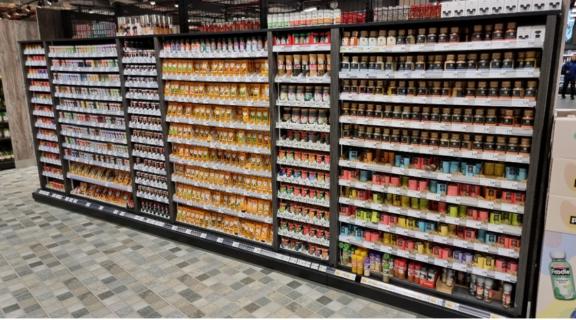
Source: Globally Cool B.V.
Besides growing interest in international cuisines, increasing demand for ethnic foods in Europe is also tied to changing demographics. The growing number of people from Middle Eastern, African or Asian backgrounds in Europe is boosting demand for foods and ingredients from those cultures.
This growing interest in international cuisines has impacted the spices sector in various ways. Traditional Eastern spice mixes have become more popular, with various retailers, including discounters, now selling spices mixes such as garam masala, ras al-hanout and baharat. This shows that demand for these mixes is part of a wider trend.
Other Middle Eastern mixes like zaatar and dukkah, for example, are also making their way into the European retail market. Relatively newer spices such as sumac, galangal and cubebin pepper are still part of the specialist spice product portfolio. Lebanese company Abido for example exports a wide range of spice mixes and spices such as sumac to Europe, targeting the ethnic market.
Figure 3: Traditional Indian (tandoori and garam masala) and Middle Eastern (baharat) organic spice mixes at a German discounter
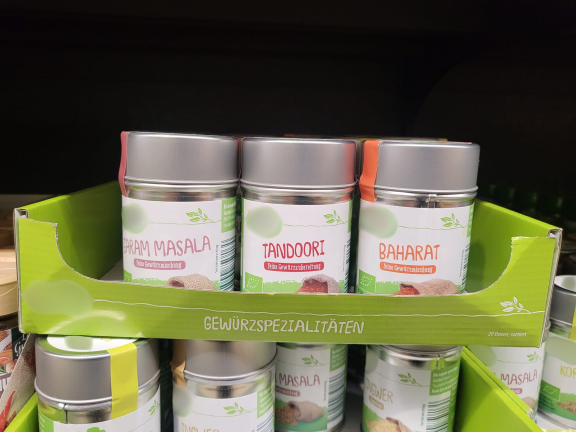
Source: Globally Cool
Demand for some specialist traditional spices, such as certain pepper and chilli varieties, has also grown. Sometimes they are offered as limited editions or seasonal launches, as demand is not high enough for these products to be sold in supermarkets year-round.
Figure 4: Whole bird’s eye chilli in grinder in the premium line of a German discounter’s seasonal range
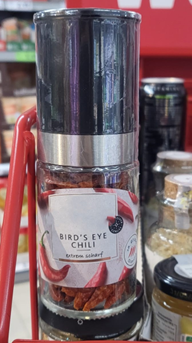
Source: Globally Cool
Exporters from developing countries expected to profit
This trend is creating opportunities for growth in the spice category overall and for imports of spices used in international cuisines, especially Asian and Middle Eastern. Demand for key spices used in mixes is expected to grow, such as for turmeric, coriander, cumin, cardamom, fennel and fenugreek for Indian mixes.
Exports of chillies should also profit from this trend as they are common in several international cuisines, including South-east Asian, Middle Eastern, African and South American. This may create market potential for new chilli varieties that add different flavour profiles to spicy mixes.
This trend also offers opportunities for new mixes and spices to enter the market. Companies looking to export new spices can take advantage of this trend by proposing mixes in which their spices can be used, giving European importers an idea of the possible market for their product.
Exporters trying to bring a new spice or spice mix onto the European market may find that their product does not meet legal requirements. This is a common challenge for new suppliers. To be compliant with EU regulations, spice production must be compliant from start to finish, including the correct use of pesticides and proper drying and storage to avoid mycotoxins.
Trend fosters overall growth of the sector
The trend of growing interest in new flavours and international cuisines is expected to expand the sector:
- Overall market growth: many spices used in ethnic mixes are already in the market. Higher consumption of spices used in mixes and processed foods will boost demand. Companies are inclined to stay with their existing suppliers, as finding new ones tends to cause compliance difficulties. Due to this trend, existing exporters are likely to see growth in their orders.
- Expansion in spice variety: as consumers become more interested in new flavours, there will be more room for new spices and herbs. New spices and herbs are therefore expected enter the European market.
- New actors in the supply chain: as new spices find their way into the European market, this will open up opportunities for new suppliers, provided they can adapt to this market’s requirements.
Tips:
- Read our study What requirements must spices and herbs comply with to be allowed on the European market? to assess if your product is compliant.
- Partner with European companies to introduce new spice blends. Traditional mixes are often adapted to suit local tastes and attract consumers in that market.
- Provide complete product documentation and specifications to your European buyers, including botanical identification of the product, organoleptic characteristics and laboratory analyses. This helps buyers evaluate your product's potential across various applications and in product development.
- Read our study on the European market for dried chillies, and watch our webinar about the European market for dried chillies and capsicums.
3. Health and wellness
Health and wellness are becoming increasingly important to consumers as they strive for a more balanced and active lifestyle. People are recognising the importance of maintaining mental, physical and emotional well-being. Over the past few years, and especially since the COVID-19 pandemic, there has been a notable rise in demand for natural products that offer health benefits. This offers growth opportunities for spices known to be healthy. Spices and herbs such as turmeric, ginger, pepper and garlic are profiting from this trend.
Superfoods
Superfoods are nutrient-rich foods known for their high concentration of beneficial vitamins, minerals and antioxidants. They gained popularity as consumers became more health-conscious and sought natural ways to enhance their diets. Marketing efforts, media coverage and endorsements by health professionals have also played a significant role in increasing awareness and consumption of superfoods.
Consumers in Europe respond positively to product labels promoting certain well-known ingredients, such as superfoods. This has opened up new opportunities for spices and herbs to be included in new product development.
Some spices and herbs are considered superfoods and have profited from this trend. Amongst the most popular superfood spices and herbs are turmeric, ginger and garlic. Other spices and herbs are also gaining popularity for their health benefits, including pepper, cinnamon and cloves. For example, yoghurt brand Actimel, produced by the global company Danone, has an ‘immune support’ range with flavours such as Actimel Mango and Turmeric Twist.
Some of the most popular spices in Europe in terms of health benefits are:
- Turmeric: one of the best known superfood spices. Market recognition of turmeric as a healthy ingredient has led to its use as in many preparations. It is mostly sold by the food industry and as a stand-alone spice. However, since the COVID-19 pandemic, consumers in certain markets such as Germany and the UK can also buy fresh turmeric in high-end supermarkets and at organic retailers.
- Ginger: like turmeric, this spice is associated with a stronger immune system. It is commonly used in infusions and other preparations claiming to support immune function and help fight the common cold. Besides its use in food preparations and as a stand-alone spice, ginger is also widely sold in fresh form in supermarkets across Europe.
- Black pepper: in the health niche, pepper has become popular as it supports the absorption of other spices, like turmeric. Therefore, it is often included in preparations that contain turmeric. Pepper is also thought to have health benefits on its own.
Other popular spices and herbs are garlic, rosemary, Ceylon cinnamon, cloves and black cumin.
Figure 5: Organic, ready-to-drink oat drinks containing spices. Focus Matcha Latte contains matcha, moringa and ginger, Balance Golden Milk contains turmeric and ginger, Focus Caffé Latte contains coffee, reishi and tonka beans
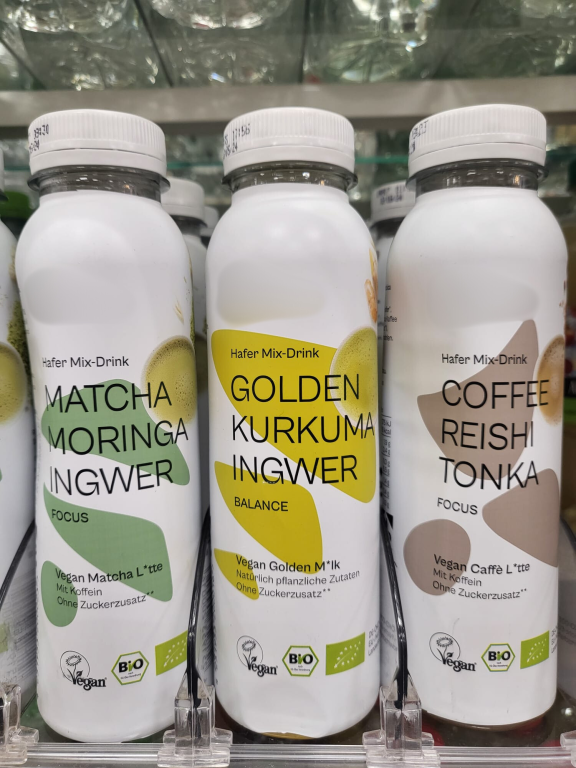
Source: Globally Cool
Traditional medicine
In the quest for preventive methods to improve health and wellness, European consumers have increasingly tapped into oriental medicinal practices, including Ayurveda and traditional Chinese medicine. In line with this trend, numerous products have been launched in Europe inspired by traditional medicine. This has opened up new markets for the spices and herbs commonly used in these traditions.
German tea and infusions brand Yogi Tea has several products based on ayurvedic tradition that contain blends of spices such as turmeric, cinnamon, cardamom, ginger, fennel, mint and pepper.
Another product that has become very popular is golden milk, also known as golden latte or turmeric latte, a beverage with an ayurvedic background made mainly with turmeric and other spices such as pepper, ginger, cinnamon and nutmeg. The popularity of this drink has resulted in the launch of many spice mixes to make it at home. At the same time, the market for turmeric and other spices in this drink is gaining market share in the restaurant segment as more cafés offer this trendy beverage as an alternative.
Organic spices and herbs are common in the health niche
Several companies marketing in the health and wellness niche offer organic products. This applies especially to new companies entering the market with new health products such as functional foods. Being organic enables new companies to differentiate themselves from market leaders and to offer products more aligned to customer expectations.
In Europe, new companies and products are being launched around the health and wellness trend. This is creating opportunities for new suppliers to enter the market. Offering organically certified spices and herbs will increase your chances of finding customers amongst these newcomers.
Healthy spices will grow
Exporters from developing countries can expect increased demand for traceable organic spices that have health benefits. Quality is very important when spices are used for the production of functional foods. Companies with traceable supply chains and strong food safety management systems will therefore be better candidates for supplying these products.
Also, companies which can demonstrate that their spices and herbs have a higher content of active substances with health benefits, such as curcumin in the case of turmeric, may be better positioned to sell their products to companies in the health segment.
Tips:
- Switch to organic agriculture and get your product certified as organic to profit from the growing health and wellness niche in Europe.
- Be cautious when making health claims about your spices. The European Union has food labelling legislation regulating the kinds of claims companies are allowed to make.
- Check the EU Health Claim Register to see if your product has any authorised health claim in the market. Keep in mind that a health claim may be for an active ingredient in the spice and not for the spice as such. For example, look for curcumin instead of turmeric.
4. Contaminant non-compliance disturbs the supply chain
High levels of contaminants in imported spices and herbs are causing concerns in the European spice market and making importers and regulators pay closer attention.
Rising incidence of contamination
High levels of contaminants in imported spices and herbs are causing concerns in the European spice market and making importers and regulators pay closer attention. In 2022, the Rapid Alert System for Food and Feed (RASFF) reported 242 incidents linked to contamination. In 2023, the number of reported cases grew to 248.
The most common issues were pesticides exceeding maximum residue limits and the presence of mycotoxins, salmonella or unauthorised substances.
Regulatory responses to non-compliance
If products from a particular country are repeatedly found not to comply with European food law, border controls for that country are increased. Products subject to temporarily increased border controls and emergency actions are listed in Annex 1 and 2 to the regulations.
Currently, nutmeg from India and Indonesia, pepper, spice mixes from Pakistan and multiple spices from Ethiopia are tested for aflatoxins more frequently (up to 50%) due to recurring non-compliance. A large variety of spices from India are also being tested in 20% of cases for pesticide residues.
Challenges for importers
The frequent physical tests conducted by border control authorities pose challenges for importers. These inspections can make it take longer to clear goods, potentially causing delays in an importer's and therefore their customers' operations.
To avoid the risk of losing goods due to failed inspections, importers are therefore evaluating samples more strictly, particularly from new suppliers. Increasingly, European importing companies are asking that products be periodically tested in laboratories of their own choosing before shipment.
Tips:
- Maintain good agricultural practices and only use pesticides that are permitted in Europe. Check the EU Pesticide database to identify restricted pesticides and active substances.
- Check out our study on requirements for spices and herbs in the European market.
- Monitor your spice drying processes to prevent a high aflatoxin content in your products. Read the CBI news article on pesticide issues in the spices sector.
5. Sourcing from new origins as a risk mitigation strategy
The global spice trade faces many challenges. Residue issues, human rights concerns and supply chain disruptions are disturbing the stability of supplies. Producers and processors are looking for more origins to source from in order to be less dependent on single suppliers and countries.
Residue and contamination issues
Spice exporters from major spice-producing countries such as China, Vietnam and Brazil are currently having problems with residues, which is affecting trade with Europe. Pesticide residues in Chinese chilli and paprika, chemical residues in Vietnamese spices and salmonella in Brazilian pepper are a major concern for European companies that buy spices from these countries. The reliability of key supply countries is also a concern for European spice importers. As a result, they are exploring alternative origins.
Supply chain disruptions and market dynamics
Global events such as the COVID-19 pandemic and wars in Ukraine and Gaza have shown the risks of relying on a single sourcing region. Sourcing from a variety of regions is important to keep supply chains stable and reliable.
Additionally, export volumes are decreasing because spice consumption is outpacing production in many Asian countries. Some have even become net importers of certain spices. Where China still exported a large amount of white pepper ten years ago, now it is a significant importer of both black and white pepper.
Climate change and weather extremes are posing added risks to spice production, causing crop failures and supply shortages. Developing new sourcing origins, pursuing a multi-origin strategy and spreading production across regions can help to mitigate these risks.
Opportunities for new spice exporters
Awareness amongst buyers of the need to source from multiple origins is creating opportunities for emerging spice-exporting countries. Those that can meet stringent quality and safety standards can take advantage of both growing demand for spices and herbs and the need for multiple sources.
Tip:
- Focus on compliance. Implement good agricultural practices and measures to be compliant with pesticide residue limits and to avoid contaminants. This will help you position yourself as a supplier from a potential complementary origin.
6. Provenance spices and herbs are in demand
Consumers want authenticity and transparency in the food market. They look for products that not only taste good but also tell a story. Clear images of ingredients and an authentic story on packaging help to get consumers’ attention. Linking spices and herbs to a specific region allows consumers to connect with that place of origin.
Single origin spices as differentiator
Origin has become important to consumers that buy premium and higher-quality products. Marking a spice as ‘single origin’ can emphasise the unique characteristics and flavours that are specific to cultivation in that region. Ceylon Cinnamon and Kampot pepper are two examples. Other widely recognised provenance spices include vanilla from Madagascar, Szechuan pepper, saffron from Iran, Aleppo pepper and nutmeg from Grenada.
Figure 6: Premium nutmeg from Grenada, with the origin clearly visible on the packaging
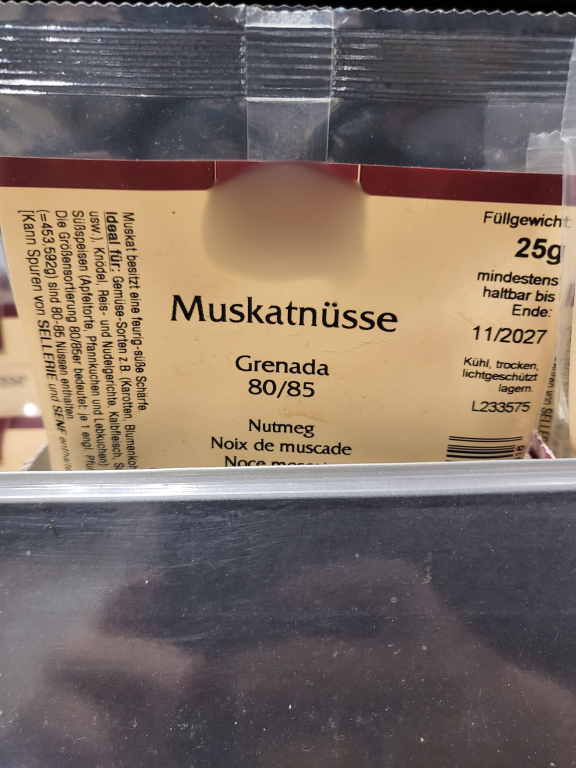
Source: Globally Cool
Origin plays a crucial role in differentiating particular spices and their characteristics. For example, Ceylon cinnamon from Sri Lanka has been granted a Protected Geographical Indication (PGI) by the European Commission. This designation differentiates Ceylon Cinnamon in the EU market and so safeguards it against lower-quality alternatives.
The PGI recognises the unique quality associated with the cinnamon's specific origin and the specialised harvesting and processing techniques used there. While products from other origins can also use botanical names such as Cinnamomum zeylanicum, they must also state their country of origin, if not Sri Lanka.
Other spices with PGIs outside Europe are Kampot Pepper (from Cambodia), Poivre de Penja from Cameroon and Safranbolu Saffron from Turkey. For the full list, see the EU’s geographical indications register.
Stating the place of origin on a product gives consumers the impression that this origin makes it is more exclusive. Some companies therefore state their spice’s origin on the packaging even if it does not have a PGI and is not known to consumers. For example, British company Bo tree has a full range of single-origin spices in addition to spice mixes. This is a strategy used mostly by specialty brands as a way to distinguish themselves from the market leaders.
The origin advantage: elevating final products
Consumer goods incorporating spices and herbs as ingredients are also capitalising on this trend by using provenance spices to boost their products’ appeal. An example is British ice cream brand Nuii. It offers a variety of ice cream bar flavours that each highlight the origin of one specific ingredient. For instance, their Almonds and Java Vanilla flavour highlights the exotic origin of its vanilla. This is a strategic move that not only distinguishes Nuii's products from competitors like Magnum (which highlights its Vanilla from Madagascar), but also makes their products more exotic and attractive to customers looking for new culinary experiences.
Figure 7: Moroccan mint tea
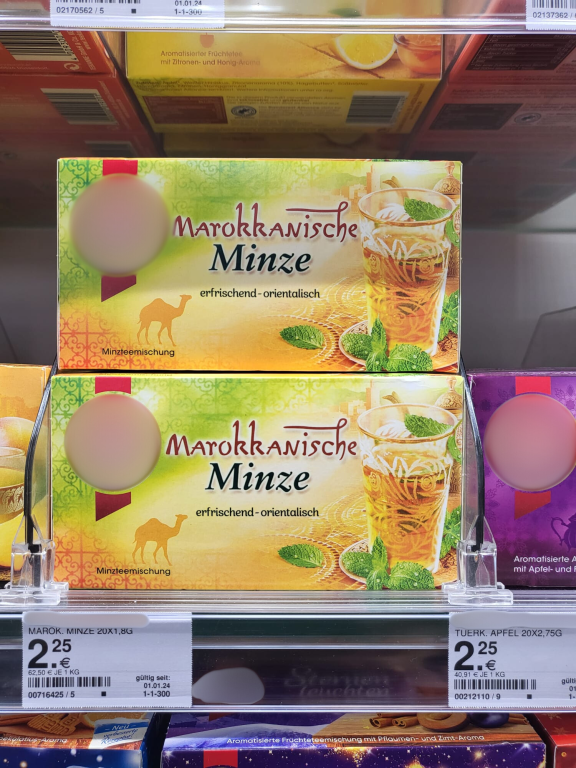
Source: Globally Cool
Sourcing single origin has extra challenges for buyers
Sourcing spices that meet European legal requirements as well as added buyer requirements (such as organic-certified, social standards, product characteristics such as curcumin content in turmeric, and minimum quantity per delivery) is a challenge in itself.
Buyers face even more challenges if they want to source from only a very specific location, especially as the availability of spices is often limited in recognised origins and the best suppliers may already be at full capacity.
On top of this, some of the most sought-after provenance spices are cultivated in traditional ways that don’t always meet modern compliance standards. For example, by drying spices in ways that could increase their aflatoxin content. As a producer, you have to resolve these barriers for your buyers.
Tips:
- In your marketing, highlight characteristics that are unique to the production regions from which you are sourcing. This will help you reach buyers in the specialty market.
- Partner with other spice producers and exporters in your region to position your origin. Two key criteria for any new origin to succeed in the international market are good volumes and steady quality. This requires joint efforts in your region or country.
7. Convenience is here to stay
Convenience products are a big category in European food retail. Consumers regularly buy ready-to-drink and ready-to-eat products. Convenience food manufacturers follow consumption trends to keep and grow their market. Key drivers in this category include trends such as interest in ethnic food (see above) and the preference for clean labels (see below).
A common new development in convenience products is the offer of Asian flavours, using spices such as paprika, turmeric, chilli, coriander, cumin, cardamom, bay leaf and others. An example is Iglo’s Fish Filet with red curry sauce. Iglo is one of the most traditional convenience brands in Germany and a long-established producer of fish-based convenience meals.
Ben’s Original brand is another example of the increasing use of spices in convenience products, following the ethnic foods and clean label trends. This flagship brand now has Cajun, Chinese and Caribbean microwave rice containing different spices.
Snacking is growing
In the convenience category, snacks, both sweet and savoury, are showing strong growth. European snack food companies are increasingly offering new flavours inspired by a range of ethnic cuisines. Nuts, crackers and crisps flavoured with different spices are common in European retail.
Figure 8: ‘African-style’ crisps, flavoured with spices including onion, garlic, coriander, turmeric and fennel

Source: Globally Cool
Besides ethnic-inspired flavours, snack producers are also growing their offer of spicy snacks, making chilli powder a very popular spice in this category.
Figure 9: Organic lentils crackers flavoured with chilli powder
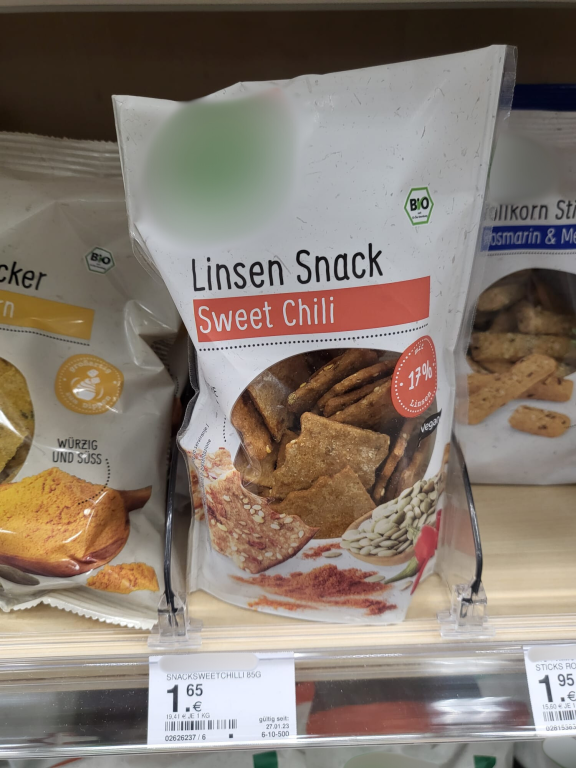
Source: Globally Cool
Tip:
- Snack producers purchase spices from importers in Europe. Work with a partner in the market to reach these companies.
8. Ready spice mixes increasingly popular in home cooking
The shift towards more at-home dining that began with the COVID-19 pandemic and has continued due to post-pandemic inflation is leading to a rise in demand for new flavours and convenience in home cooking. This has popularised ready spice mixes and created opportunities for bulk imports and repackaging in Europe, as well as for ethnic products in specific markets.
Demand for fancy at-home culinary experiences
Consumers are eating more at home than out. This trend started with the COVID-19 pandemic, when consumers had to stay home and restaurants and cafés were closed. While out-of-home consumption improved after the pandemic, it remains lower than before, due partly to the inflation that followed.
With consumers increasingly seeking fancy and adventurous culinary experiences, there is growing demand for new flavours and spices to elevate home cooking. This trend is being driven by consumers’ desire to replicate restaurant-quality dishes in the comfort of their own homes.
Desire for convenience and sophistication
Although everyday European home cooking may have become more sophisticated, consumers still want to spend less time preparing their food. Convenience products that ease and speed up the preparation of fancy foods are therefore very welcome in the European pantry.
Ready spice mixes tailored to specific dishes have become increasingly popular, as they provide a quick and hassle-free solution for home cooks. These days, spice aisles in European retail shops offer not only single spices but also many spice mixes, ranging from curry mixes to spice mixes for simple meals like scrambled eggs or for seasonal drinks like pumpkin lattes.
Figure 10: Spice mixes for avocados, bruschetta, chips and pizza in German retail
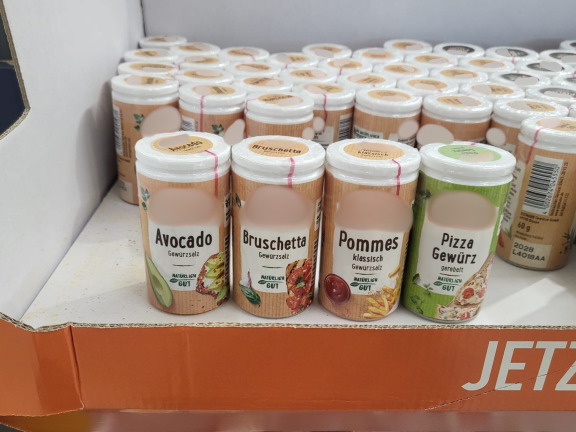
Source: Globally Cool
Most European companies produce their own spice mixes from imported spices. However, as the trend for importing ground spices grows, there will be more room for companies in developing countries to offer their own mixes in bulk for repackaging in Europe. In the case of ethnic products, such as spice mixes sold in ethnic supermarkets, there are opportunities to export the finished good.
For example, Lebanese company Abido exports spices and spice mixes to Europe, specifically targeting the ethnic market. They currently sell a wide range of spice mixes and single spices, including sumac.
Tips:
- Look for companies specialised in ethnic products to present your ready-mixed packages for retail. A well-known brand from your country of origin may appeal to consumers who share your cultural background.
- Target repackers for the mid and low segment to offer ground spices and spice mixes in bulk.
- Read the CBI’s studies tips to find buyers and tips to do business to find potential buyers in Europe.
9. Clean labels in the spotlight
European consumers increasingly want to know what is in their food. Consumers now prefer natural foods over heavily processed ones, with a focus on healthy, nutritious offers. Synthetic flavours and additives are coming to be seen as undesirable ingredients in packaged foods. Instead of long, complex ingredient lists, consumers are looking for short and understandable lists of familiar ingredients. This trend offers opportunities for spices and herbs to become more popular in the food industry.
Turmeric is one of the spices that has profited most from this trend. Used mainly as a natural colorant in the industry, turmeric’s good reputation makes it a perfect choice for processed food manufacturers that want to cater to this trend.
Creating food industry solutions that are ‘clean’ and provide the same dispersion, texture and other characteristics of current synthetic additives requires research. Manufacturers of additives for the food industry are therefore developing new solutions to meet both industry requirements and consumer demand. For example, German company LENA Natural has developed a red colorant from red sweet pepper (Capsicum annuum L) that is a stable food colourant and also looks natural on product labels.
Another example from Germany is Food Ingredients Anthes F.I.A., a company specialised in flavouring mixes for the food industry, which has developed a line of mixes in line with the clean label trend.
This trend is expected to contribute to gradual growth of the spice market in Europe in the coming years.
Tip:
- Target companies that are developing flavours, extracts and spice mixes. They buy large quantities of spices and may be interested in direct sourcing.
Globally Cool carried out this study on behalf of CBI.
Please review our market information disclaimer.
Search
Enter search terms to find market research
